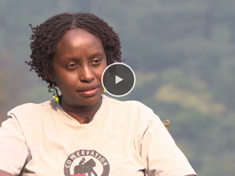-
CNN Profiles the Work of Conservation Through Public Health in Uganda
June 9, 2014 By Kate Diamond
Reporting on long-term, complex human-environment interactions can be daunting. As the saying goes, “if it bleeds, it leads,” and slow, sometimes-distant changes rarely make headlines. Yet, earlier this year CNN International’s African Voices program took a stab at it, diving into the world of integrated development in a three-part profile of Conservation Through Public Health (CTPH), a Ugandan NGO that is working to preserve one of Central Africa’s most important biodiversity hotspots while strengthening the health and wellbeing of nearby communities.
Reporting on long-term, complex human-environment interactions can be daunting. As the saying goes, “if it bleeds, it leads,” and slow, sometimes-distant changes rarely make headlines. Yet, earlier this year CNN International’s African Voices program took a stab at it, diving into the world of integrated development in a three-part profile of Conservation Through Public Health (CTPH), a Ugandan NGO that is working to preserve one of Central Africa’s most important biodiversity hotspots while strengthening the health and wellbeing of nearby communities.
Scabies in gorillas was traced to people living around the park who had very little health careCTPH works in the southwest corner of Uganda in and around Bwindi Impenetrable National Park, home to about half of the world’s remaining mountain gorillas. The gorillas were what first brought CTPH Founder and CEO Gladys Kalema-Zikukosa to the area, but when a scabies outbreak hit human communities, she quickly learned that if she wanted to protect the gorillas she needed to work more closely with people too.
“We had scabies in gorillas in 1996, when I was the vet for the Uganda Wildlife Authority, and that was traced to people living around the park who have very little health care,” Kalema-Zikusoka, a New Security Beat contributor, told CNN. The outbreak taught her that “sometimes what you need to do about it is not only treat the gorilla, but also address the human health issues or the livestock health issues.”
CTPH staffs 120 local workers in village health and conservation teams to teach people living near the park about basic sanitation and hygiene techniques and safe behavior around gorillas. As the health and conservation teams have earned trust and buy-in from local communities, they have also unearthed new needs: more paths for families to move out of poverty; better access to family planning so women can choose when and how many kids to have; internet access to connect the area to the rest of the country; and clean cookstoves to reduce deforestation and minimize the health risks of indoor smoke inhalation.
In turn, community buy-in has allowed the gorillas space to thrive in Bwindi.
From Poachers to Rangers
When the park was created in 1991, people living within its boundaries were forced to resettle elsewhere (no small feat in one of the most densely populated corners of Africa). In neighboring countries, national parks have been beset by poaching and other criminal activity, turning them into something more akin the Wild West than nature preserves. In Bwindi, however, “when [it] was created as a park, it was done in a very clever way, a very strategic way,” Kalema-Zikusoka told CNN. “They got people who were poachers, and they employed them as rangers or trackers, because they know the forest really well. And they realized they were earning more by being rangers, protecting the wildlife, than killing it.”
“Unless you have an economic reason for keeping these gorillas alive…people are tempted to kill them because they are destroying their livelihoods”The resulting eco-tourism has been a boon to an impoverished region. Out of 30 gorilla groups in the park, 10 are habituated for tourist visits with each bringing in a minimum of $1 million in tourism revenue every year, said Kalema-Zikusoka.
“Unless you have an economic reason for keeping these gorillas alive, sometimes when they come out to people’s gardens and raid their crops, people are tempted to kill them because they are destroying their livelihoods,” she said. “But if you say no, these gorillas are bringing tourists, and the tourists are building schools, roads, you know, giving employment, all of that, then they’ll think twice before they even think about killing a gorilla.”
CTPH’s work in and around Bwindi is showing results. The mountain gorilla population is up from 760 in 2008 to 880 now. Overall, as many as 44,000 people have received some kind of health service through the organization’s work. Eleven times as many tuberculosis patients are being seen in clinics, and twelve times as many people are using family planning relative to before CTPH added it to its portfolio.
Kalema-Zikusoka’s story shows how embracing complexity can be key to successful development. Moving forward, CTPH show no signs of slowing down: not only do they continue to add services to their portfolio in Bwindi, they are also helping to lead a national population, health, and environment working group to support integrated development throughout Uganda. With staggering biodiversity and a population that’s projected to more than double by 2050, they may have their hands full.
Sources: CNN, Conservation Through Public Health.
Video Credit: CNN International’s ‘African Voices.’
 A Publication of the Stimson Center.
A Publication of the Stimson Center.




